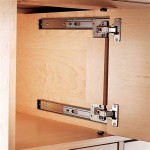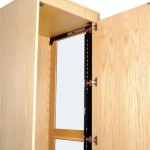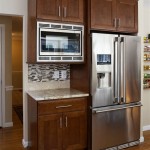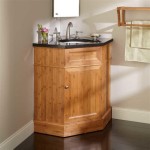Where To Place Handles On Shaker Cabinets In Your Kitchen
Shaker cabinets, characterized by their simple, clean lines and recessed panel doors, are a timeless and versatile choice for kitchen design. Their understated elegance allows them to seamlessly integrate into a variety of styles, from modern farmhouse to traditional. However, the seemingly straightforward design of Shaker cabinets belies the importance of detail. One crucial element that can significantly impact the overall aesthetic and functionality of Shaker cabinets is the placement of hardware, specifically handles.
The selection and placement of handles are not merely decorative considerations; they are integral to the cabinet’s usability and visual harmony. Incorrectly placed handles can disrupt the clean lines that define Shaker style, making the kitchen feel unbalanced or awkward. Conversely, well-placed handles enhance both the aesthetic appeal and the practical function of the cabinets, providing comfortable grip and effortless access to stored items.
This article will explore the optimal placement of handles on Shaker cabinets, considering both aesthetic principles and ergonomic factors. It will provide a comprehensive guide to ensure that your hardware placement complements the Shaker design, promotes user comfort, and contributes to a visually appealing and functional kitchen space. Key considerations include the type of cabinet (upper or lower), the size and orientation of the door or drawer, and the overall design scheme of the kitchen.
Understanding the Principles of Symmetry and Balance
Symmetry and balance are fundamental principles in design, and their application is particularly crucial when dealing with Shaker cabinets. The clean lines and geometric shapes inherent in Shaker design inherently lend themselves to symmetrical arrangements. When placing handles, striving for visual balance can significantly enhance the overall aesthetic appeal of the kitchen.
For upper cabinets, a common approach is to place handles horizontally. This placement often aligns with the stile (the vertical frame member) of the Shaker door. Positioning the handle on the stile creates a visually balanced look and ensures structural integrity, as the stile provides a solid mounting point for the hardware. The exact vertical placement on the stile is often determined by the door's height. A general rule of thumb is to position the handle approximately 2.5 to 3 inches from the bottom edge of the upper cabinet door. This height is generally considered comfortable and aesthetically pleasing.
However, variations to this rule may be necessary based on individual preferences and specific design considerations. For example, if the upper cabinets are significantly taller than standard sizes, the handle placement may need to be adjusted upwards to maintain visual balance. It is recommended to visually assess the handle placement before final installation to ensure the proportions appear harmonious.
Lower cabinets, on the other hand, often benefit from vertically oriented handles. This placement generally aligns with the upper portion of the stile, near the top edge of the door. Similar to upper cabinets, the vertical orientation provides a comfortable grip and contributes to a balanced visual effect. The exact placement can vary depending on the height of the lower cabinet door, but a common guideline is to position the handle between 2.5 to 3 inches from the top edge of the door. This placement allows for easy access while maintaining a visually consistent appearance throughout the kitchen.
For drawers, the placement of handles depends on the size and style of the drawer. Smaller drawers often benefit from a centrally located handle. This approach creates a symmetrical and balanced look, particularly when the drawers are arranged in a row. Larger drawers, however, may benefit from two handles, which provide better leverage and distribute the weight more evenly when opening and closing the drawer. When using two handles on a drawer, ensure they are placed symmetrically on either side of the drawer center, typically aligning with the stiles of the Shaker drawer front.
Maintaining consistency in handle placement throughout the kitchen is essential for achieving a cohesive and visually appealing design. Regardless of the specific placement on each cabinet or drawer, strive for uniformity in height or alignment. This consistency creates a sense of order and harmony, enhancing the overall aesthetic of the kitchen.
Considering Functionality and Ergonomics
While aesthetic considerations are important, the placement of handles must also prioritize functionality and ergonomics. Handles should be positioned to provide a comfortable and natural grip, facilitating effortless access to the contents of the cabinets and drawers. Incorrectly placed handles can lead to awkward movements, discomfort, and potentially even strain or injury.
The height of the user is a primary factor to consider when determining handle placement. Standard guidelines for handle placement are generally based on average heights, but adjustments may be necessary to accommodate individuals who are significantly taller or shorter. For example, if the primary user of the kitchen is shorter in stature, the handles on lower cabinets may need to be positioned slightly higher to ensure easy reach. Conversely, if the user is particularly tall, the handles on upper cabinets may need to be positioned slightly lower.
The type of handle selected can also impact functionality and ergonomics. Different handle styles offer varying degrees of grip and comfort. For example, bar-style handles typically provide a more secure and comfortable grip than knob-style handles, particularly for larger or heavier doors and drawers. When selecting handles, consider the ease of gripping and the amount of force required to open and close the cabinet or drawer. It is advisable to test different handle styles to determine which ones offer the best combination of comfort and functionality.
The weight and size of the cabinet doors and drawers should also be considered when determining handle placement. Larger and heavier doors and drawers require more leverage to open and close, so the handles should be positioned to maximize leverage. This often means placing the handles closer to the edge of the door or drawer, where the force can be applied more effectively. Additionally, consider using two handles on larger drawers to distribute the weight more evenly and reduce the strain on the drawer mechanism.
Accessibility is another crucial factor to consider, particularly for individuals with mobility limitations. Handles should be easy to reach and grip, without requiring excessive bending or stretching. D-shaped handles or pull-style handles are often a good choice for individuals with limited hand strength or dexterity, as they provide a larger gripping surface and require less force to operate. It is important to carefully consider the needs of all users when determining handle placement to ensure that the kitchen is accessible and user-friendly for everyone.
In addition to the above considerations, consider the proximity of adjacent appliances and fixtures. Handles should be placed in a manner that avoids creating obstructions or interfering with the operation of other kitchen elements. For example, ensure that the handles on cabinet doors do not collide with the handles of nearby appliances, and that they do not obstruct access to countertops or sinks.
Specific Placement Guidelines for Different Cabinet Types
While general principles of symmetry, balance, and ergonomics provide a foundation for handle placement, specific guidelines may vary depending on the type of cabinet. Upper cabinets, lower cabinets, drawers, and specialty cabinets each require slightly different approaches to ensure optimal functionality and visual appeal.
For standard upper cabinets with a single door, the handle is typically placed horizontally on the stile, approximately 2.5 to 3 inches from the bottom edge of the door. This placement provides a comfortable grip and aligns with the eye level, creating a balanced visual effect. If the upper cabinet has two doors, a handle is typically placed on each door, mirroring the placement on a single-door cabinet. The handles should be positioned on the stiles, approximately 2.5 to 3 inches from the bottom edge of each door.
For standard lower cabinets with a single door, the handle is typically placed vertically on the stile, approximately 2.5 to 3 inches from the top edge of the door. This placement provides a comfortable grip and aligns with the hand's natural position when reaching down to open the cabinet. If the lower cabinet has two doors, a handle is typically placed on each door, mirroring the placement on a single-door cabinet. The handles should be positioned on the stiles, approximately 2.5 to 3 inches from the top edge of each door.
For drawers, the handle placement depends on the size and style of the drawer. Small drawers, typically less than 12 inches wide, often benefit from a single handle placed in the center of the drawer front. This placement creates a symmetrical and balanced look, particularly when the drawers are arranged in a row. Larger drawers, typically between 12 and 24 inches wide, may benefit from two handles, placed symmetrically on either side of the drawer center. This provides better leverage and distributes the weight more evenly when opening and closing the drawer. Extra-large drawers, typically over 24 inches wide, should almost always have two handles to ensure proper support and ease of use.
For specialty cabinets, such as pantry cabinets or corner cabinets, the handle placement may require a more customized approach. Pantry cabinets, which are typically taller than standard cabinets, may require handles that are positioned slightly lower than usual to ensure easy reach. Corner cabinets, which often have angled doors or unique configurations, may require handles that are placed at a slightly different angle to accommodate the door's shape. In these cases, it is recommended to experiment with different handle placements to determine the optimal position for both functionality and aesthetics.
In addition to the above guidelines, consider the overall design scheme of the kitchen when determining handle placement. If the kitchen features a more modern or minimalist design, the handles may be placed in a more unconventional or asymmetrical manner. Conversely, if the kitchen features a more traditional or formal design, the handles may be placed in a more symmetrical and conservative manner. The key is to ensure that the handle placement complements the overall aesthetic of the kitchen and contributes to a cohesive and visually appealing design.

How To Install Handles And Knobs On Shaker Drawer Fronts True Position Tools

Cabinet Hardware Placement Guide For Shaker Cabinets

5 Classic Shaker Kitchen Cabinet Hardware Ideas That Ll Stand The Test Of Time

Shaker Cabinet Handle Installation With The Hardware Jig True Position Tools

How To Install Handles And Knobs On Shaker Drawer Fronts True Position Tools
Cabinet Hardware Placement Where To Put Knobs And Handles Vevano

5 Classic Shaker Kitchen Cabinet Hardware Ideas That Ll Stand The Test Of Time

Shaker Cabinet Hardware Placement Guide Where Should The Pulls And Knobs Go Maplevilles Cabinetry

Shaker Cabinet Handle Installation With The Hardware Jig True Position Tools

5 Classic Shaker Kitchen Cabinet Hardware Ideas That Ll Stand The Test Of Time
Related Posts








